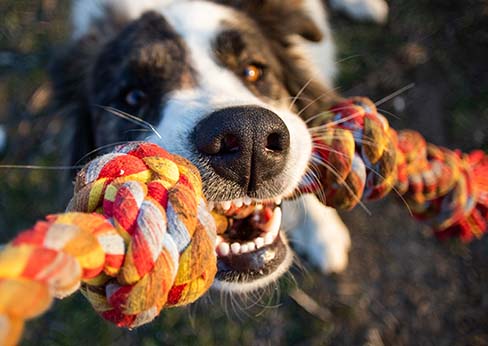In this post:
- Tug-of-war rules
- Tug-of-war benefits
- Does tug-of-war cause aggression in dogs?
Tug-of-war is a great way to help your dog or puppy release energy in a controlled environment. Tug-of-war is actually a great way to practice keeping control over your dog when she’s excited. Tug-Of-War does not teach your dog to be aggressive. It is a great learning tool and a wonderful way to bond with your dog.
ALWAYS supervise children playing with dogs. Accidents happen. Your dog could easily bite too hard and hurt your child. Your child might not be able to read your dog and know when the dog has reached a level of arousal that is not appropriate.
Tug-of-war rules:
As always, roughhousing needs to have rules so that everyone stays safe and enjoys themselves.
- You should always initiate it. This way, the dog or the puppy knows when to start. This will prevent them from trying to play with just anyone. I use “Get it Truffle” or “Kill It” and present an appropriate toy. It is really important that your dog does not tug without you first telling him that it is okay.
- You have to be in control at all times. I suggest adding training to get control over play. Every so often, get your dog to release the tug toy and add a different training break — ask for a sit, down, stand, down, another sit, then restart the game as a reward.
- If he makes contact with your skin or tries to tug on you, yelp and stop play. You want to teach your dog or puppy to only bite on the toy, not you.
- If he gets too riled up stop playing and do a time out. If he continues to get too wild, stop playing for the rest of the day.
- You control when the playtime is over. I tell my dogs “All Done” (yes, the same thing as their release word for “stay” and “wait”) this lets my dog know that they are doing what they were doing. If your dog or puppy does not stop playing, just walk away and be BORING!
Never hold the tug above the head and lift up on the dog. It can cause a lot of damage to their throats.
Tug-of-war benefits
The Whole Dog Journal has a great article about the benefits of controlled tug-of-war. Some of them include:
- Tug-of-war helps build a healthy relationship with your dog or puppy
- Tug-of-war teaches self-control
- Tug-of-war creates a useful distraction
- Tug-of-war builds confidence
Most importantly, tug-of-war reinforces training. Playtime is one of the most arousing and distracting activities your dog can partake in. By periodically stopping play and asking your dog to perform a task or a command, you are participating in positive reinforcement training. The reward is getting to play! This strengthens those behaviors and you will have a higher rate of success when you ask your dog to perform them in public.
Does tug-of-war cause aggression in dogs?
“Playing tug of war with a dog will not necessarily cause them to become aggressive. How you play tug of war might lead to aggressive behaviors, but it’s remarkably easy to stay on the right path.” – Jason Nicholas. If you follow the rules above, you should not have any issues. He also adds, “…you should NOT play tug of war with a dog that is already aggressive, a resource guarder (aggressively protects their food, toys, etc.), or is showing early signs of either. Tug of war won’t make your dog aggressive, but it might intensify unwanted behaviors or patterns that are already present.” Work with a professional dog trainer or animal behaviorist to solve any underlying aggression or resource guarding and pick some other games.
A study by the Journal of Applied Animal Welfare Science filmed 50-dog owners playing with their dog with their chosen game followed by a 1-hour test.
The study found:
“…no evidence that games play a major deterministic role on dominance dimensions of dog-human relationships” and “how dogs play reflects general attributes of their temperament and relationship with their owner“by Journal of Applied Animal Welfare Science
Final thoughts:
Playtime is so much fun for both humans and dogs. It brings us closer and makes our bond so much stronger. Tug-of-war is a great tool to use up energy, practice your commands, and overall, bond with your dog. However, it is important to follow these rules: you should always initiate, you should control the game, and the dog must stop when you ask him to.





